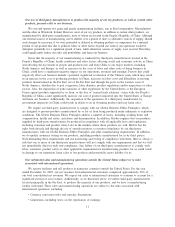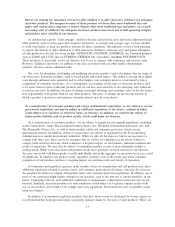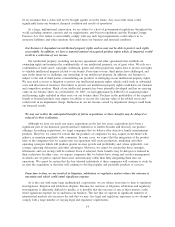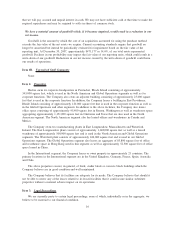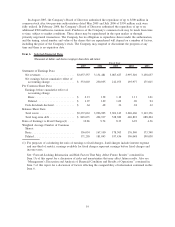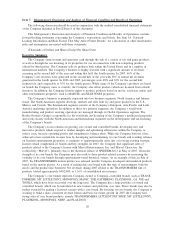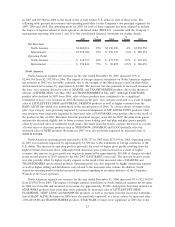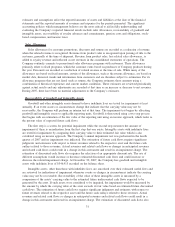Hasbro 2007 Annual Report Download - page 29
Download and view the complete annual report
Please find page 29 of the 2007 Hasbro annual report below. You can navigate through the pages in the report by either clicking on the pages listed below, or by using the keyword search tool below to find specific information within the annual report.In addition to its focus on core brands, the Company’s strategy also involves trying to meet ever-changing
consumer preferences by identifying and offering innovative products based on market opportunities and
insights. The Company believes its strategy of focusing on the development of its core brands and continuing
to identify innovative new products will help to prevent the Company from being dependent on the success of
any one product line.
While the Company’s strategy has continued to focus on growing its core brands and developing
innovative new products, it will continue to evaluate and enter into arrangements to license properties when
the Company believes it is economically attractive. In 2006, the Company entered into a license with Marvel
to produce toys and games based on Marvel’s portfolio of characters. The Company had significant sales of
products related to this license during 2007, primarily due to the theatrical release of SPIDER-MAN 3 in
May of 2007. The Company has also incurred royalties on products based on the theatrical release of
TRANSFORMERS in July 2007. While gross profits of theatrical entertainment-based products are generally
higher than many of the Company’s other products, sales from these products also incur royalty expenses
payable to the licensor. Such royalties reduce the impact of these higher gross margins. In certain instances,
such as with Lucasfilm’s STAR WARS, the Company may also incur amortization expense on property right-
based assets acquired from the licensor of such properties, further impacting profit made on these products.
The Company’s long-term strategy also focuses on extending its brands further into the digital world. As
part of this strategy, in August 2007, the Company announced a multi-year strategic agreement with Electronic
Arts Inc. (“EA”). The agreement gives EA the exclusive worldwide rights, subject to existing limitations on
the Company’s rights and certain other exclusions, to create digital games for all platforms, such as mobile
phones, gaming consoles and personal computers, based on a broad spectrum of the Company’s intellectual
properties, including MONOPOLY, SCRABBLE, YAHTZEE, NERF, TONKA and LITTLEST PET SHOP. As
part of this agreement, the Company has also obtained the rights to create toys and non-digital games based
on EA’s intellectual properties. The first games under this agreement are expected to launch in 2008.
While the Company remains committed to investing in the growth of its business, it continues to be
focused on reducing fixed costs through efficiencies and on profit improvement. Over the last 5 years the
Company has improved its operating margin from 7.8% in 2002 to 13.5% in 2007. The Company reviews it
operations on an ongoing basis and seeks to reduce its cost structure in an efficient manner. In 2006 the
Company announced a reduction of its manufacturing activity in Ireland and transition of the manufacture of
certain products to the Company’s suppliers in China, and recently the Company announced a restructuring of
its games manufacturing facility in the U.S. that is also expected to result in work practice efficiencies and
cost reductions. The Company is also investing to grow its business in emerging international markets and will
continue to evaluate strategic alliances and acquisitions which may complement its current product offerings
or allow it entry into an area which is adjacent to and complementary to the toy and game business. For
example, in January of 2008, the Company acquired Cranium, Inc., which develops and markets a wide range
of CRANIUM branded games and related products. In 2008, the Company expects to leverage revenue to
offset the impact of these investments on its operating margins.
In recent years, the Company has been seeking to return excess cash to its shareholders through share
repurchases and dividends. As part of this initiative, over the last three years, the Company’s Board of
Directors (the “Board”) has adopted three repurchase authorizations with a cumulative authorized repurchase
amount of $1,200,000. After fully exhausting the prior two authorizations, the third authorization was passed
on August 2, 2007 for $500,000. During the third and fourth quarters of 2007, $390,399 of common stock was
repurchased under this authorization. For the years ended 2007, 2006 and 2005, the Company invested
$587,004, $456,744 and $48,030, respectively, in the repurchase of 20,795, 22,767 and 2,386 shares,
respectively, in the open market. Also, in May of 2007, the Company paid $200,000 in cash to repurchase
exercisable warrants to purchase 15,750 shares of the Company’s common stock. Subsequent to December 30,
2007, the Board approved an additional $500,000 share repurchase authorization. The Company intends to
opportunistically repurchase shares in the future subject to market conditions. In addition, in February 2008,
the Company announced an increase in its quarterly dividend to $0.20 per share. This was the fifth consecutive
year that the Board has increased the dividend.
21


